15 August 2024
![]() 8 mins Read
8 mins Read
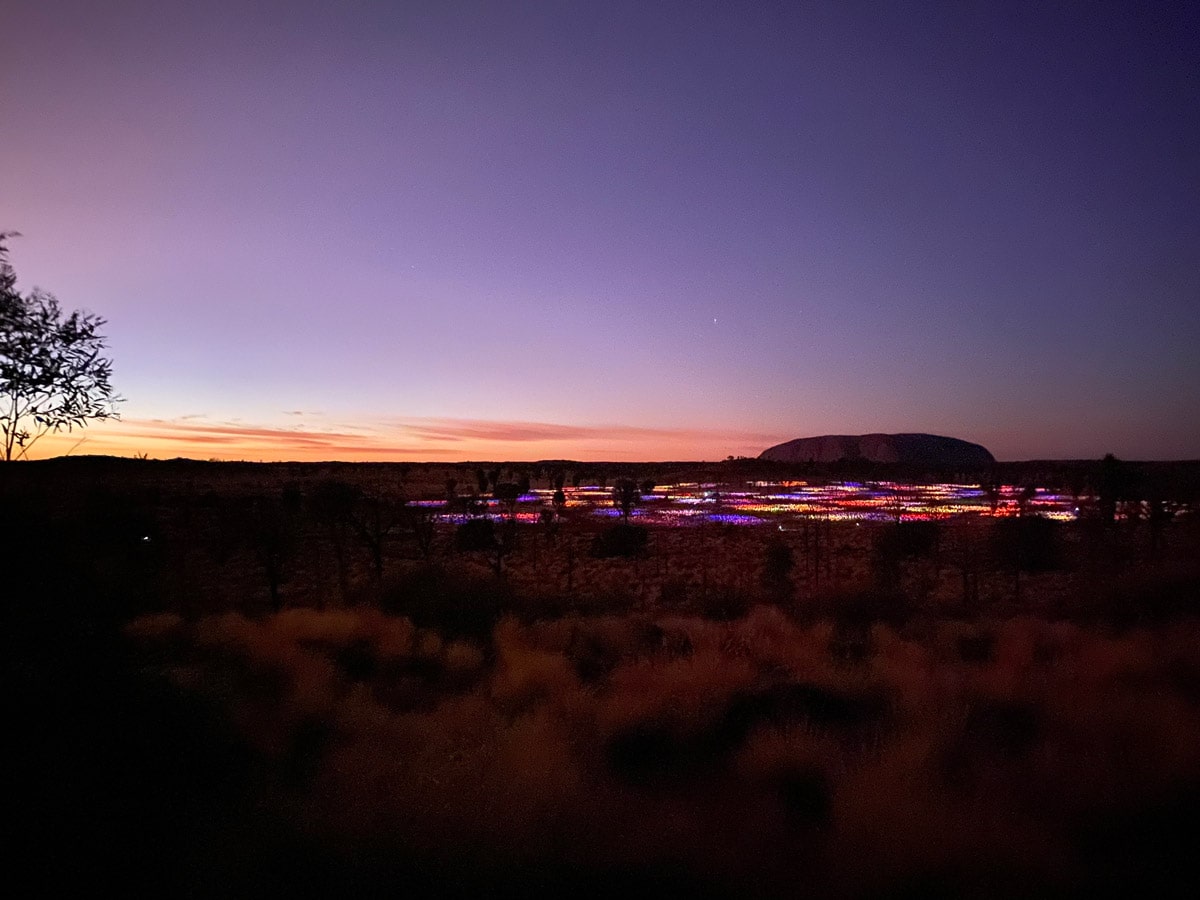
Bruce Munro has every right to be “bloody petrified”. Sure, the logistical riddle of amassing 50,000 lights in the Central Australian desert is reputation-threateningly perplexing. But add to this the multicultural complexity of placing one of this continent’s largest ever art installations smack bang near Uluru, the sacred heart of a culture that has been there “since the first sunset”.
This self-effacing “Pom” is fully aware that his choice of canvas is a sensitive one, with a well-documented history of white men trampling willy-nilly over its sacred sites.
“I couldn’t just be a Westerner coming here to impose ideas on this landscape – this is the Anangu’s [the traditional owners’] landscape,” says Munro.
Munro describes his negotiations with Anangu elders as a “gentle, four-year discourse”, where he tried to convey the spirit and scope of the project. But try explaining to anyone why you want to dump four football fields’ worth (49,000 square metres) of changing-hued frosted lights in the outback.
“It’s hard to visualize and abstract – you really have to see it to understand,” he says.

Bruce Munro, the man of light: Creator and artist behind Field of Light, Uluru (photo: Mark Pickthall).
The Anangu community seem to have embraced the installation, helping to clear the land using traditional fire-stick farming techniques, and translating the name into their language, Pitjantjatjara. Tellingly, elders also asked Munro if they could do their own interpretation of the lights down the track.
As of its opening night back in April 2016, the Field of Light is the largest iteration of Munro’s immersive light displays that have graced various landscapes including a field behind his house in southwest England and various sites in the US. He insists, however, that Uluru is something of a homecoming for him as an artist. Back in 1992, on his farewell trip after living in Australia for eight years, Munro and his partner finally made it to the Red Centre (only just) in a “banger” of an old Toyota Corona.
He couldn’t have predicted as he sketched the idea into his notebook, while camping in Uluru, the unprecedented demand his ‘swan song’ would create.
“It sounds like a cliché, but seeing Uluru actually changed my life,” he says. “That inspiration gave me a chance to work full-time as an artist.
“And I think that the Anangu understand that I have no ulterior motive – I just want to express how this place has changed my life.”
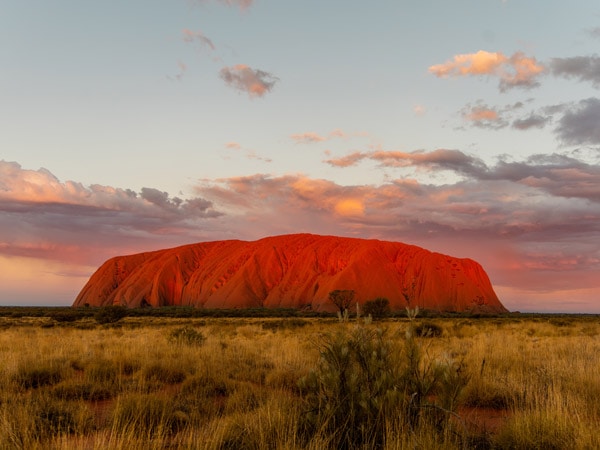
The impact of seeing Uluru inspired Bruce Munro’s Field of Light. (Image: Tourism-NT/ Bronte Stephens)
To appreciate art that defines itself only in relation to darkness, you’ll have to prepare to become one of the nocturnal desert mammals; immerse yourself in the desert before the sun kisses the outback horizon and wander through it well after sunset.
From the dune-top viewing area in daylight, the Field of Light merely resembles an incongruous, glistening patch of wild dandelions among the spinifex-rich deep red earth. Stubborn desert oaks spectate in wonder.
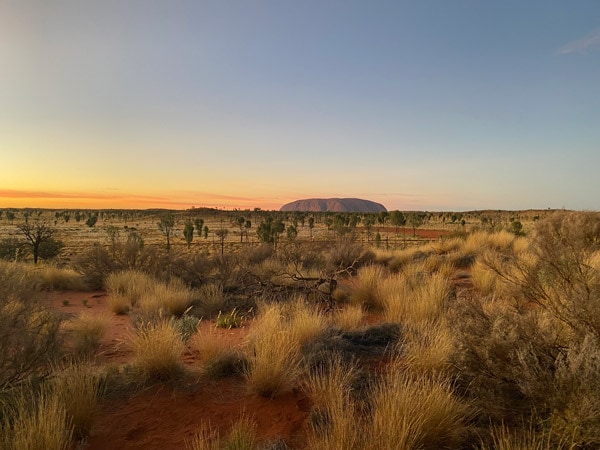
The Field of Light disappears in daylight. (Image: Katie Carlin)
At dusk, glass of Champagne in hand, the installation barely draws your eye from The Rock’s awesome presence (it’s located just outside the national park, a respectable distance from Uluru).
Then at twilight, the splendour of the outback stars are intent on pilfering the show. For the Field of Light, it must be like coming on stage after The Beatles have warmed up the crowd for you.
Immersed at eye level is where you want to be after dark. Wander out of the blackness into the impromptu avenues that dissect rhythmic waves of mutable hues, to a chorus of chirping crickets, and accompanied by a tender desert breeze.
It feels like you’ve landed in a psychedelic Netherlands bulb field – subtle violets, soft electric blues and limes, gentle ochres, spectral whites.
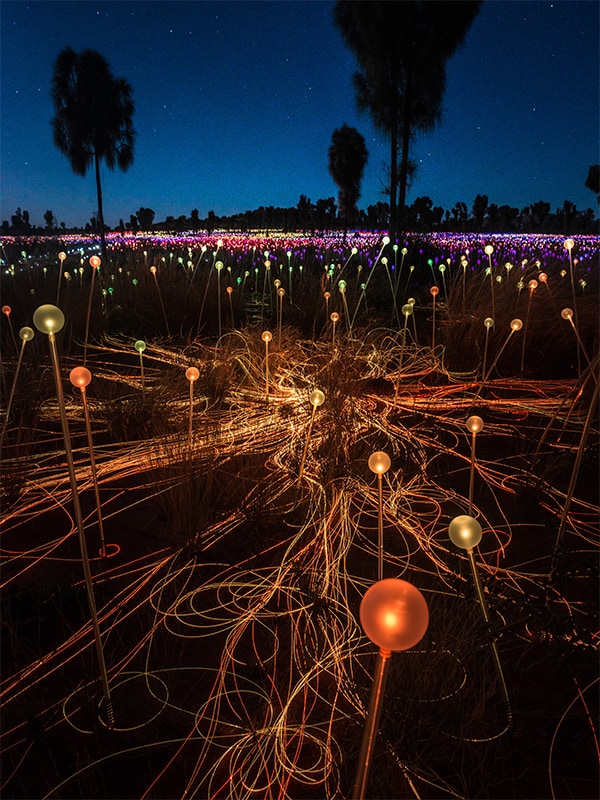
The Field of Light has become one of the most popular Uluru attractions.
Local artist-in-residence Heather Dunn underlines the futility of comparing the lights with the “natural atmospherics” of the desert.
“The Field of Light is only a complement to a grand space; to the transitory things that happen to Uluru, the colour and change,” she says.
“It’s only when Uluru goes to sleep, that this thing takes over on the ground while the stars do above. At first, you think, ‘oh, yeah, there it is; it’s not doing much’, but it starts to build, like an orchestra. Then you get among it!”
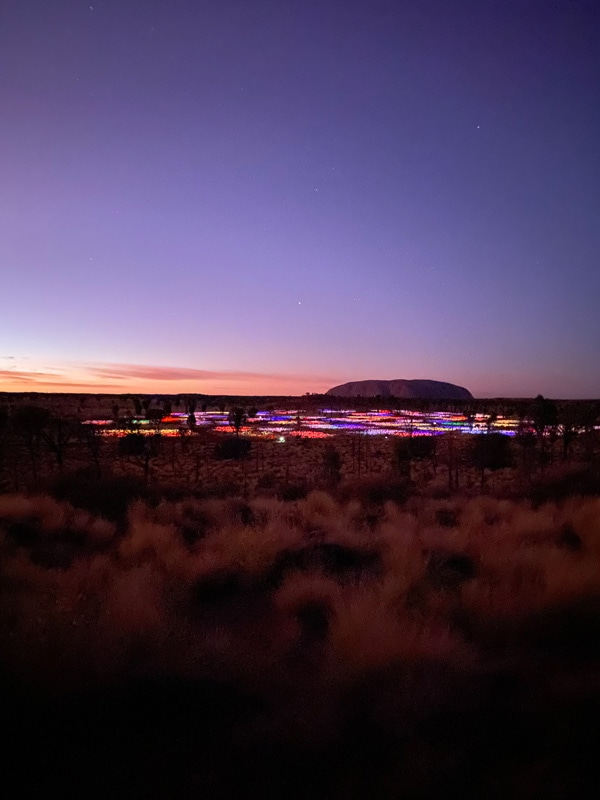
It is futile to compare the Field of Light with the wonder of Uluru. (Image: Katie Carlin)
Around 380 kilometres of crisscrossed fibre-optic cables creep along the ground; tendrils of silvery light, a confusion of trippy snail trails.
Munro chose a colour palette sympathetic to the desert, omitting deep greens because he saw none way back in 1992. Instead, the spindly stems breathe and sway through a sympathetic desert spectrum of ochre, deep violet, blue and white.
Not only is this his first solar-powered work (well, there are not many power outlets in the desert), but it’s also “a lot less designed” and geometric than its forerunners; a concession to the untamable desert scape.
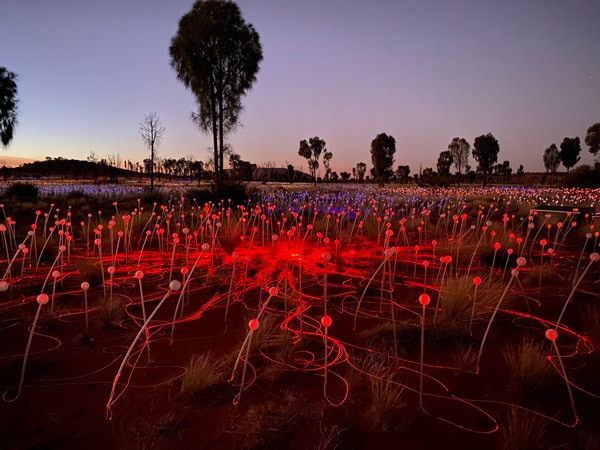
The Field of Light is coloured a desert spectrum of ochre, deep violet, blue and white. (Image: Katie Carlin)
But back in daylight, with some truly local knowledge, you realise that this most modern of art installations is not just sitting alone on a barren desert, but actually on the cusp of a monumental outdoor gallery.
Literally, hundreds of Aṉangu rock paintings and etchings perch among the crags and nooks of Uluru and nearby Kata Tjuta (the Olgas), embedded physically and metaphysically into the landscape and lore.
Each on its own seems sparse and simple, surely no match for the lights, but collectively they weave an immensely bigger picture.
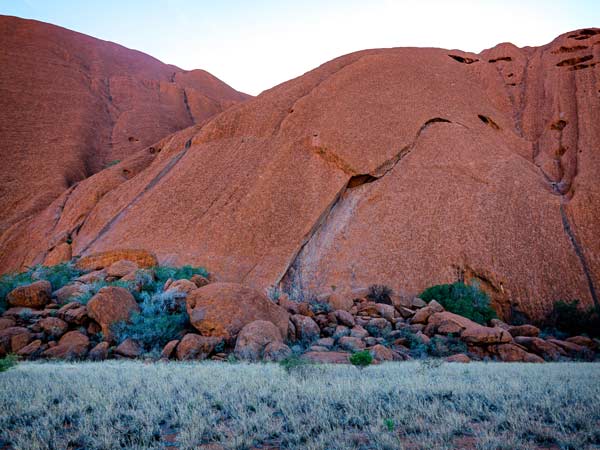
For Anangu art is about survival in the desert landscape. (Tourism NT/ Kate Flowers)
“Art is about survival out here,” says Anangu man Leroy Lester, from Wintjiri Arts & Museum. “In places like Kakadu, they’ve got plenty of food so they had lots of time to paint things like big barramundis with all the organs. We had no time for that.
“Out here, especially when it’s dry, you’d rather drink the water than mix ochre with it. The main art was body paint and ceremonies – but even ceremonies were cancelled in times of drought.”
According to Leroy, art out here acts like a billboard spruiking Tjukurpa (creation stories). The Rock is a physical embodiment of it and the Anangu read them both like a scripture and as a daily life roadmap.
“The paintings might show a big lizard, so everyone who’s looking for a big lizard to eat can find one. Or so you can find a waterhole.”
While Uluṟu is primarily just a powerful muse for Munro, he does relate to one principle of Anangu art and culture; a sense that the past informs the present.
“It intrigues me that the Anangu have an interwoven concept of time that reflects mine: of time past, when I first saw Uluru; of time present, the exhibition now; and time future, how once this has been swept away, the living memory that goes into people’s hearts and minds.”
The living memory is enough to sate Munro, aware that the Field of Light is barely a grain of sand in Uluru’s grand narrative. “I actually like the fact it’s ephemeral – you can flick it on and off.”
He’s not the kind of artist to scribble his name on a tree trunk or cast a bronze statue (and much of the installation will be recycled, too). “Ultimately, I think we’re all just pushing ideas through time.”

The last glow of the Field of Light before it disappears with the sun. (Image: Katie Carlin)
The Field of Light (also named Tili Wiru Tjuta Nyakutjaku or ‘looking at lots of beautiful lights’ in the local language) is now showing indefinitely.
It is currently open for tours with a Field of Light pass ($45). The four-and-a-half-hour, three-course A Night at Field of Light Dinner inspired by bush tucker costs $280 per person (with Australian wines and beers as well). Other options include a Field of Light Star Pass with viewings of the work and outback canapes with sparkling wine or beer.
Ayers Rock Resort offers an array of family-friendly accommodation options including the five-star Sails in the Desert. Book ahead to go glamping at Longitude 131.
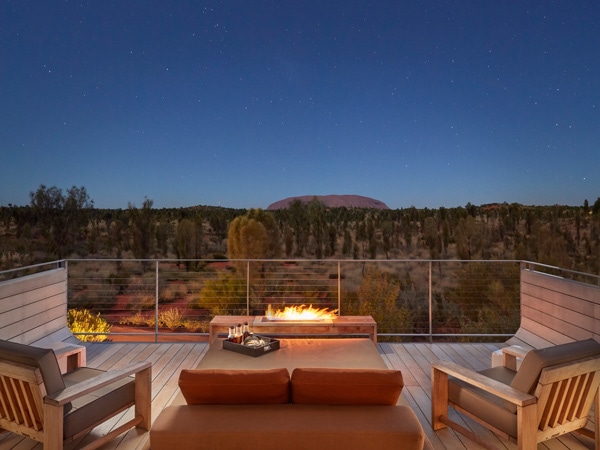
Longitude 131’s collection of pavilions provides jaw-dropping views of Uluru and Kata Tjuta. (Image: Tourism NT and George Apostolidis)
Jetstar, Qantas and Virgin fly regularly to Ayers Rock Airport, Uluru.
A Field Of Light? ELECTRIC Light? WHY? People do STUPID things to show off their EGO, and because they’ve got alot of money. ART? I think not! Its NOT NATURAL!!
Have just returned from Uluru yesterday. Stayed at Sailes and had a marvelous time. We cycled around Uluru (total 14-15 km), Visited Kata Tjuta and also went to the Field of lights installation. All absolutely marvelous. Can’t fully tick off my bucket list yet as we didn’t have time to do Kings Canyon – a future visit hopefully!
You definitely need to return for Kings Canyon, Julie. We love the Red Centre too!
I achieved a life long dream visiting Uluru staying 4 days at Ayers Rock Resort. ULURU is not just ‘ a rock’ Wow, I found it magical with a life of its own ! No wonder it is a holy place to the Aboriginals. Prompting my decision to go was the Field Of Light. Am so glad (& thankful) that I could go – as not a cheap holiday but worth it !
It certainly is, Vicky. You don’t hear too many people regretting their decision to go to The Rock.
Wanted to see this installation but due to covid I could not travel there in 2020. Am visiting in July this year, why is it finished?